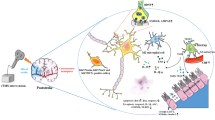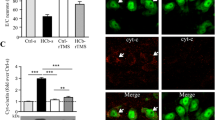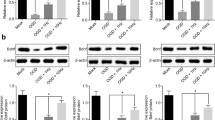Summary
The effect of transcranial magnetic stimulation (TMS) on the neurological functional recovery and expression of c-Fos and brain-derived neurotrophic factor (BDNF) of the cerebral cortex in rats with cerebral infarction was investigated. Cerebral infarction models were established by using left middle cerebral artery occlusion (MCAO) and were randomly divided into a model group (n=40) and a TMS group (n=40). TMS treatment (2 times per day, 30 pulses per time) with a frequency of 0.5 Hz and magnetic field intensity of 1.33 Tesla was carried out in TMS group after MCAO. Modified neurological severity score (NSS) were recorded before and 1, 7, 14, 21, and 28 day(s) after MCAO. The expression of c-Fos and BDNF was immunohistochemically detected 1, 7, 14, 21, and 28 day(s) after infarction respectively. Our results showed that a significant recovery of NSS (P<0.05) was found in animals treated by TMS on day 7, 14, 21, and 28 as compared with the animals in the model group. The positive expression of c-Fos and BDNF was detected in the cortex surrounding the infarction areas, while the expression of c-Fos and BDNF increased significantly in TMS treatment group in comparison with those in model group 7, 14, 21, and 28 days (P<0.05) and 7, 14, 21 days (P<0.01) after infarction, respectively. It is concluded that TMS has therapeutic effect on cerebral infarction and this may have something to do with TMS’s ability to promote the expression of c-Fos and BDNF of the cerebral cortex in rats with cerebral infarction.
Similar content being viewed by others
References
Alvaro P L. Repetitive transcranial magnetic stimulation: Technical principles, safety, and potential therapeutic applications. EEG Clin Neurophysiol, 1997,103(4):48
Fujiki M, Kobayashi H, Abe T et al. Repetitive transcranial magnetic stimulation for protection against delayed neuronal death induced by transient ischemia. J Neurosurg, 2003,99(6):1063–1069
Jin X, Wu X W, Wang J F et al. Effect of transcranial magnetic stimulation on rehabilitation of motor function in patients with cerebral infarction. Natl Med J China (Chinese), 2002,82(8):534–537
Chen Y, Constantini S, Trembovler V et al. An experimental model of closed head injury in mice: pathophysiology, histopathology, and cognitive deficits. J Neurotrauma, 1996,13(10):557–568
Takemoto O, Tomimoto H, Yanagihara T. Induction of c-fos and c-jun gene products and heat shock protein after brief and prolonged cerebral ischemia in gerbils. Stroke, 1995,26(9):1639–1648
Collaco-Moraes Y, Aspey B S, de Belleroche J S et al. Focal ischemia causes an extensive induction of immediate early genes that are sensitive to MK-801. Stroke, 1994,25(9):1855–1860
Post A, Keck M E. Transcranial magnetic stimulation as a therapeutic tool in psychiatry: what do we know about the neurological mechanisms. J Psychiatr Res, 2001,35(4):193–215
Sander D, Meyer B U, Roricht S et al. Effect of hemisphere selective repetitive magnetic stimulation on middle cerebral artery blood flow velocity. Electroencephalogr Clin Neurophysiol, 1995,97(1):43–48
ZHU Y L. Brain plasiticity and function reorgnization. Chin J Inter Med (Chinese), 2000,39(8):567–568
Huang X L, Han X H, Guo T C et al. Effects of electroacupuncture combined with transcranial magnetic stimulation on VEGF and Flk21 expression in cerebral ischemia in rats. Chin J Phys Rehabil (Chinese), 2004,26(10): 581–584
Huang F N, Cao Q L, Sheng D G et al. Experiment on safety considerations in normal and infarct rats transcranially stimulated with magnetic fields. Chin J Phys Med (Chinese), 1998, 20(8):136–139
Sun Yi, Tang X F, Guo Y P. Experimental safety studies of transcranial magnetic stimulation. Chin J Neurol (Chinese), 1996,29(4):217–221
Author information
Authors and Affiliations
Additional information
ZHANG Xiaoqiao, male, born in 1975, Doctor in Charge
Rights and permissions
About this article
Cite this article
Zhang, X., Mei, Y., Liu, C. et al. Effect of transcranial magnetic stimulation on the expression of c-Fos and brain-derived neurotrophic factor of the cerebral cortex in rats with cerebral infarct. J. Huazhong Univ. Sc. Technol. 27, 415–418 (2007). https://doi.org/10.1007/s11596-007-0416-3
Received:
Issue Date:
DOI: https://doi.org/10.1007/s11596-007-0416-3




